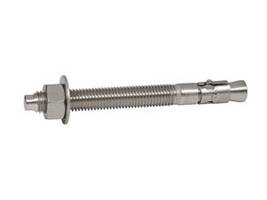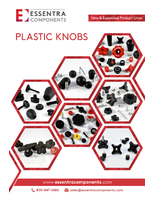New 316 Stainless Steel Wedge Anchors with 2% to 3% More Molybdenum
Press Release Summary:

- Available in different diameters and different lengths
- 3/8” wedge anchor requires 3/8” hole to be drilled in the concrete
- Used in industrial applications involving processing chemicals, as well as in high saline environments
Original Press Release:
316 Stainless Steel Wedge Anchors
“The 316 stainless steel wedge anchor is most commonly used in industrial applications involving processing chemicals, as well as in high saline environments, where de-icing such as coastal regions and outdoor areas salts are commonly used,” stated Bob Carlisle, the founder and President of Concrete Fastening Systems, Incorporated.
“The 316 stainless steel also has 2% to 3% more molybdenum than you would find in other grades of stainless steel anchors, which increases its corrosion resistance,” said Carlisle, sharing his experience and knowledge gained from working in the fastening industry since 1981.
316 Stainless Steel Wedge Anchors Guide
Base Material
Wedge anchors are recommended for use only in solid concrete base materials, and should not be used in hollow materials such as brick or block.
Holding Values
Because the holding values of wedge anchors are the same regardless of their manufacturing material, 316 stainless steel wedge anchors have the same pullout strength and shear capacity as other wedge anchors.
- Pull Out – each diameter of wedge anchor has a minimum depth of embedment into the concrete that will ensure minimum pullout strength. An embedment that is deeper than the minimum embedment will usually produce higher pullout values.
- Sheer – The sheer value does not change with embedment depth, and is directly related to the diameter of wedge anchor being used.
Hole Diameter
The hole drilled in the concrete is equal to the diameter of the 316 stainless steel wedge anchor being installed, therefore a 3/8” wedge anchor requires a 3/8” hole to be drilled in the concrete. Hole to wedge anchor tolerance is critical for proper holding values.
Hole Depth
Wedge anchors do not require the bottom of the hole to be set and must be a minimum of 1/2” deeper than the embedment of the wedge anchor. This allows space for dust created during the installation to fall into and out of the way.
Type of Bit
The bit used to drill the hole in the concrete must have a carbide tip, meet ANSI standards and be used in a hammer drill that both rotates and hammers.
- Carbide Tip – carbide is very hard and is used on the tip to pulverize the concrete plus to remove the dust from the hole.
- ANSI Standards – ensures proper tolerance between the bit and hole size required for installing wedge anchors, and it is a good idea to double-check their labeling.
- Hammer Drill – the only way to ensure a proper hole in the concrete is to use a hammer drill. The hammer motion pulverizes the concrete while the rotation and flutes on the bit remove the dust at the proper rate. It is also important that the switch on the drill is set in the hammer and rotation mode before drilling the hole in the concrete.
Sizes
316 stainless steel wedge anchors come in different diameters and different lengths. The first number in the description refers to the diameter of the anchor and the second number refers to the length.
- Diameter- depends on engineer specifications, on the diameter of the hole in the item being fastened and on the required holding value amounts.
- Length – is determined by adding the thickness of the item being fastened to the minimum embedment for the diameter being installed, plus space for the nut and washer.
316 stainless steel wedge anchor purchase direct from the manufacturer at www.confast.com.



